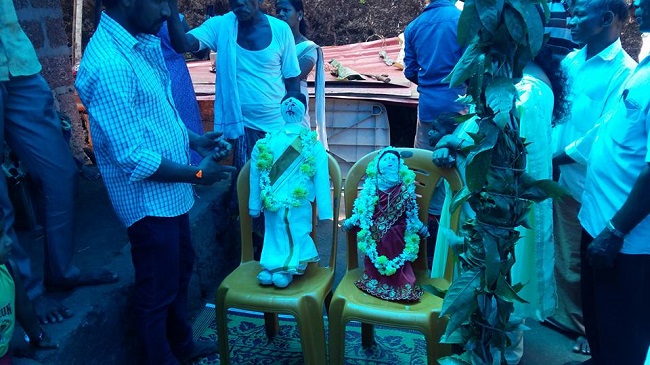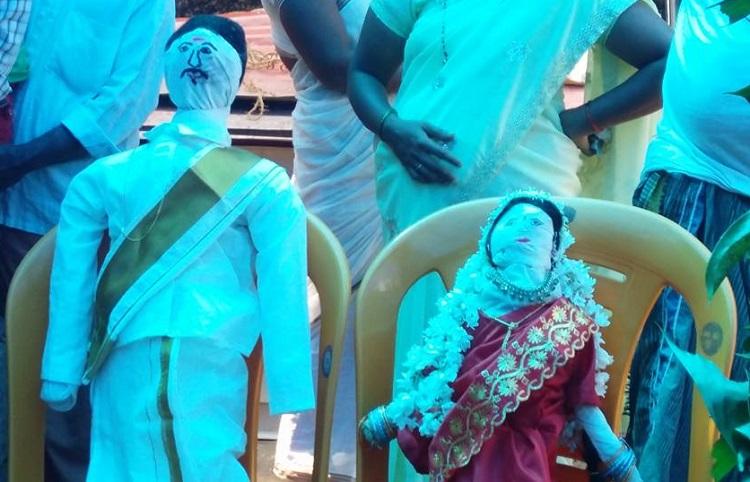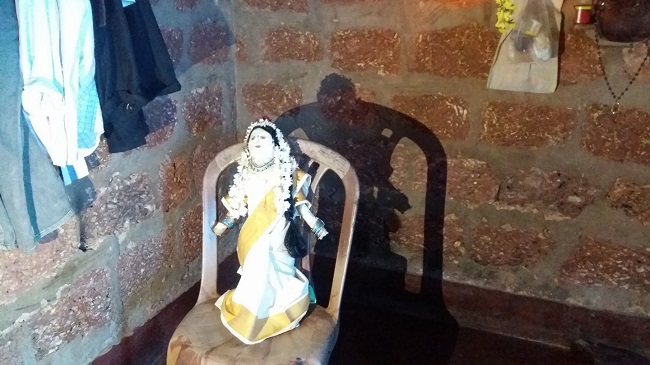Kasargod’s Ghost weddings: Why dead children are married off in this Kerala district?
p>Sukanya and Ramesh got married to each other last week, on October 29. An arranged marriage held at Sukanya’s house in Kasargod’s Perla, the wedding was conducted adhering to all the Hindu customs. Their horoscopes were made and matched, both the families consented to the wedding, thali (mangalsutra) was tied around Sukanya’s neck, garlands exchanged, and the ceremony ended with a sumptuous Kerala sadya (lunch on a banana leaf.)
Except, neither Sukanya nor Ramesh were really present at the wedding, considering they both died several years ago, while they were still babies.

Instead, it was their effigies that represented them: Sukanya dressed in a dark pink silk saree, adorned with a necklace, hands full of bangles and fresh jasmine flowers on her hair; and a mundu-clad Ramesh; both made of wood and hay. Around them stood their close family members, happy at the union.
This was clearly not a regular wedding, but a ‘Pretha Kalyanam’ – a wedding of ghosts.
What is ‘Pretha Kalyanam’?
The practice of ‘marrying off’ the deceased is a ritual followed by certain communities in the northern district of Kasargod. The ritual is prevalent among the Nalkadaya, Mogeyar and Mavilan communities, who live on the outskirts of the district, bordering Karnataka.
A ‘Pretha Kalyanam’ is conducted between a bride and a groom who died as children – before they turned 18 and could be married.
The idea of a ‘Pretha Kalyanam’ is to alleviate bad things happening with a particular family. The people from these communities believe that if any of the children have passed away before the age of 18, their souls wander, without attaining peace. This, in turn, is believed to bring bad luck to the family members, especially the siblings of the deceased.

Explaining the ritual, B Sreelakshmi, a student of B.Ed, who did a dissertation project on the age-old practice, says:
“Suppose a foetus gets aborted, or a child dies in a family, and years later, the other children in the family face some difficulties in their lives, like impediments in their marriage or problems conceiving children… In such circumstances, the family approaches an astrologer, who tells them that the soul of the child, who died years ago, needs to be laid to rest. The only way to do so is to conduct the child’s wedding, since the child left the earth before it could experience worldly pleasures.”
The groom’s family makes an effigy of the groom using either wood, hay or silver. The bride’s family, too, does the same for her. On the day of the wedding, their siblings, or any other close relatives, perform the wedding rituals, from exchanging the garlands to putting the sindhoor on the bride’s forehead.
After the ceremonies are over and the invitees are fed, the groom’s family takes leave, along with the newly weds. Once at their house, the effigies are either kept under a Pala tree, or they are immersed in a water body. Some people even cremate the effigies, which forms the last leg of the ritual.

Saji Rag, a Malayalam school teacher from Kasargod who attended Sukanya and Ramesh’s wedding, tells TNM that the couple’s effigies were made of hay and wrapped in white cloth.
“Normally, after the wedding rituals, the bride and the groom have to walk around the temple. In this wedding, it was the brother of the bride took both the effigies and walked around the trunk of a pala tree, symbolically believed to the wedding hall,” he says.
Age-old ritual or superstition?
While the practice was quite common earlier, now the number of ‘Pretha Kalyanam’ held with the knowledge of the public, has decreased drastically, Saji adds. He says that Sukanya and Ramesh’s was the second such wedding to be conducted in Perla this year.
Explaining the motive behind the ritual, Sreelakshmi says, “The families believe that once this ritual is conducted, the bad omens will go away and that they will have prosperity in life. When we look at it critically, it is nothing but a psychological game.”
She adds that among the communities of Nalkadaya, Mogeyar and Mavilan, the ritual is part of their ethnic Tulu culture, which is a way of respecting the departed.
Although previously, the wedding used to be conducted with the cooperation of the entire neighbourhood, several community members are now deciding to discreetly conduct the ritual, Sreelakshmi points out. It is the changing mindset of the people towards such rituals that have contributed to such a shift, she says.
“With the coming of the younger generation, people are terming the practice as a superstitious act and many from these communities themselves don’t agree with such rituals. With this, the weddings that earlier saw the participation of the whole locality, are now much smaller, with just the close family involved,” she says.
(All images provided by Saji Rag)


















